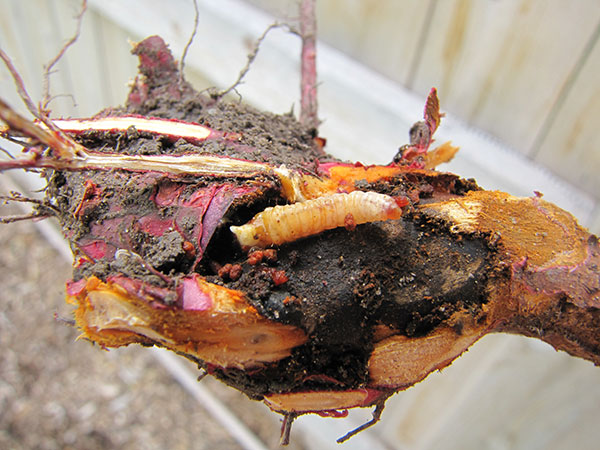Greater Peachtree Borer
 Adult Male (left) and Female (right) Greater Peachtree Borers
Adult Male (left) and Female (right) Greater Peachtree Borers
 Greater peachtree boorer larva and tunnel under the tree bark.
Greater peachtree boorer larva and tunnel under the tree bark.
 Sap oozing at the base of the tree in response to the borer attack.
Sap oozing at the base of the tree in response to the borer attack.
HOSTS
- Apricot
- Cherry
- Chokecherry
- Nectarine
- Peach
- Plum
- Prune
DESCRIPTION
The greater peachtree borer (Synanthedon exitosa) is a sporadic pest in Utah stone fruit orchards, but if left unmanaged it can be severe enough to cause tree loss. The adults are clearwing moths. The larvae are pinkish-white caterpillars that bore into the trunks where they feed just under the bark in the cambial tissue. There is one generation per year, but some larvae may require to years to complete development.
Extensive larval feeding can girdle and kill trees. The larvae primarily attack tree trunks at or below the soil line, but may enter trunks up to 12 inches above the ground.
BIOLOGY
Adults are similar in appearance to wasps with a metallic-blue body and clear wings, the females fore-wings are covered with blue scales. Eggs are reddish brown, oval, and hard. They can be found on the lower tree trunk under bark scales, on rough bark, or on nearby soil. Larva are pinkish-white with a brown head. They bore through the bark immediately upon hatching and feed on inner bark and cambium of the tree, forming galleries.
SYMPTOMS
- Sawdust and frass mixed with the gummy exudate near the base of the trunk.
- Sap oozing at the base of the tree.
- Loose, dead bark.
- Yellow and wilted leaves on a portion of the tree.
- Skins of pupae left attached to the bark of the lower trunk or in the soil near the trunk base.
- Larval tunnel under the bark.
GENERAL MANAGEMENT
Protection of host trees from peachtree borer is the most critical during the first 3 to 5 years after planting. There are few registered insecticides with adequate longevity to protect trunks from egg-laying and hatching larvae. Mating disruption is the recommended control for commercial stone fruit orchards. For orchards less than 1 acre, or for home yard trees, preventive trunk sprays is the primary control.
Insecticides:
Only a small number of products are registered for peachtree borer that have adequate longevity to protect trees from egg-laying and tunneling larvae for several weeks to a month.
Cultural and Mechanical Controls:
- Select appropriate fruit tree species for the site to avoid stressed and unhealthy trees.
- Use good cultural practices (i.e., fertilization, irrigation, etc.) to maintain trees in a healthy and vigorous state.
- Paint trunks with a 1:1 dilution of white latex paint to water, or apply white tree wraps in the winter to prevent bark damage from sunscald.
- Do not leave wraps on trees during the summer. This has been shown to increase borer attack.
- Avoid mechanical and rodent-caused injuries to trunks.
- Certain rootstocks have been found to result in fewer emerging adults. ‘Siberian C’ peach rootstock had 40% fewer emerging adults than ‘Lovell’ rootstock in one study.
- Keep the base of trees free of vegetation. Heat and dryness reduce the survival of eggs and larvae.
How to Monitor for the Greater Peachtree Borer


